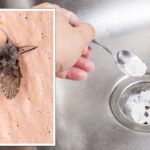How to Get Rid of Drain Flies: A Comprehensive Guide
Drain flies, also known as moth flies or filter flies, are small insects that thrive in moist environments, particularly around drains, sinks, and sewage systems. Although they do not pose a direct health threat, their presence can be quite annoying and may indicate underlying sanitation issues. This article will provide a detailed overview of drain flies, their life cycle, how to identify them, and effective methods for eliminating them from your home.
1. Understanding Drain Flies
1.1 What Are Drain Flies?
Drain flies are tiny, grayish-brown insects that typically measure about 1/8 to 1/4 inch in length. They have fuzzy bodies and wings that give them a moth-like appearance. These flies are often found in damp areas, particularly where organic matter accumulates, such as in drains, sewage systems, and garbage disposals.
1.2 Life Cycle of Drain Flies
The life cycle of drain flies consists of four stages: egg, larva, pupa, and adult. Understanding this life cycle is crucial for effective pest control.
- Egg: Female drain flies lay their eggs in moist organic matter, often in the slime found in drains. A single female can lay up to 200 eggs at a time.
- Larva: The eggs hatch into larvae within 48 hours. The larvae feed on organic material and can grow rapidly in favorable conditions.
- Pupa: After several days, the larvae pupate, transforming into adult flies. This stage lasts about 2 to 3 days.
- Adult: Once they emerge as adults, drain flies can live for about 15 days, during which they reproduce and continue the cycle.
2. Identifying Drain Flies
2.1 Physical Characteristics
Drain flies can be identified by their:
- Size: Typically 1/8 to 1/4 inch long.
- Color: Grayish-brown with a fuzzy appearance.
- Wings: Long and rounded, often held roof-like over their bodies.
- Movement: They tend to hop rather than fly, making them appear clumsy.
2.2 Signs of Infestation
Common signs of a drain fly infestation include:
- Adult Flies: Seeing small flies near drains, sinks, or other damp areas.
- Dark Specks: Finding small, dark specks (droppings) near breeding sites.
- Larvae: Observing small, white larvae in the slime of drains.
3. Why Are Drain Flies a Problem?
While drain flies do not bite or transmit diseases, they can be a nuisance and may indicate unsanitary conditions. Their presence often suggests that there is organic matter accumulating in drains, which can attract other pests and lead to more significant hygiene issues.
4. How to Get Rid of Drain Flies
4.1 Natural Remedies
Natural remedies can be effective in eliminating drain flies without the use of harsh chemicals. Here are some popular methods:
4.1.1 Boiling Water
Pouring boiling water down the drain can kill larvae and help clear organic matter. Repeat this process once or twice a day for several days to ensure effectiveness.
4.1.2 Baking Soda and Vinegar
Mixing baking soda and vinegar creates a fizzing reaction that can help break down organic material in drains. Pour 1/2 cup of baking soda followed by 1/2 cup of vinegar down the drain, let it sit for several hours, and then flush with hot water.
4.1.3 Apple Cider Vinegar Trap
Create a trap using apple cider vinegar. Fill a bowl with apple cider vinegar and add a few drops of dish soap. The vinegar attracts the flies, and the soap reduces the surface tension, causing them to drown.
4.2 Chemical Solutions
If natural remedies do not work, consider using chemical solutions:
4.2.1 Drain Cleaners
Commercial drain cleaners can help eliminate organic buildup in pipes. Follow the instructions on the label and ensure proper ventilation when using these products.
4.2.2 Insecticides
Insecticides specifically designed for flying insects can be used to kill adult drain flies. Apply according to the manufacturer’s instructions, focusing on areas where flies are seen.
5. Preventing Future Infestations
To prevent drain fly infestations, implement the following strategies:
5.1 Regular Cleaning
Regularly clean your drains to remove organic matter. Use a pipe brush to scrub the inside of the pipes and flush with hot water.
5.2 Fix Leaks
Address any plumbing leaks or moisture issues in your home to eliminate potential breeding grounds for drain flies.
5.3 Use Drain Covers
Cover drains when not in use to prevent adult flies from entering and laying eggs.
6. When to Seek Professional Help
If the infestation persists despite your efforts, it may be time to call a professional pest control service. They can assess the situation and provide targeted treatments to eliminate drain flies effectively.
7. Frequently Asked Questions (FAQ)
How do I know if I have a drain fly infestation?
Signs include seeing small flies near drains, finding dark specks around breeding sites, and observing larvae in the slime of drains.
Can drain flies spread diseases?
Drain flies do not bite or transmit diseases, but they can carry bacteria and contaminate food preparation surfaces.
How long does it take to get rid of drain flies?
With consistent treatment, most infestations can be resolved within a week or two.
Can I prevent drain flies from coming back?
Yes, regular cleaning, fixing leaks, and using drain covers can help prevent future infestations.
Are drain flies harmful?
While drain flies are not harmful, their presence can indicate unsanitary conditions that may attract other pests.
8. Conclusion
Drain flies can be a persistent nuisance, but with the right approach, you can effectively eliminate them and prevent future infestations. By using natural remedies, chemical solutions, and preventive measures, you can reclaim your home from these unwelcome guests. Regular maintenance and cleanliness are key to keeping drain flies at bay, ensuring a healthier and more comfortable living environment.
Relevant Information
| Topic | Link |
|---|---|
| Drain Flies | Wikipedia article on Drain Flies |



